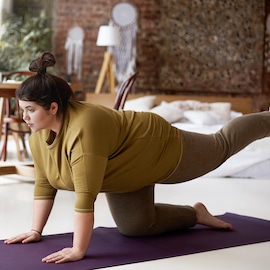
The Absolute 5 Best Exercises to Do When You’re Overweight
When you're overweight, jumping into popular fitness crazes like Crossfit or High Intensity Interval Training (HiiT) can be physically unsafe, not to mention emotionally devastating.

When you’re overweight, jumping into popular fitness crazes like Crossfit or High Intensity Interval Training (HiiT) can be physically unsafe, not to mention emotionally devastating. Still, there are effective ways to get moving and change your body and life for the better. These options lead the pack in getting results without breaking you down with misery.
1) Swimming
Whether you work on your breaststroke, join a water polo team or get into hardcore aqua jogging, swimming is excellent for people who have extra weight on their frames. The buoyancy from the water takes pressure off typical problem areas like the lower back and knees, supporting up to 90% of your weight and making it easier to shift through a full range of motion. At the same time, water is denser than air, providing decent resistance–you’ll actually work harder in the pool than out of it because of this, obliterating up to 400 calories an hour.
2) Yoga or Pilates
Yoga combines stretching and isometric (static body weight) movements. It is known not just for increasing flexibility, but also for increasing strength. Pilates has similar goals, but it focuses on strengthening the smaller, intrinsic muscles, particularly those around the spine and core region. These are good options if you’re heavier because the added mobility and intrinsic strength they provide allow you to safely try more challenging moves and exercises. They provide wonderful physical awareness, as well, teaching you to get in tune with and respect your body regardless of what the scale says. Most Yoga and Pilates moves have simple, no-fuss modifications to alter intensity, letting you personalize your program and adjust as you get stronger.
3) Slide and Glide
Slide and glide programs rely on only a set of exercise discs, which are designed to sit under the balls of your feet and slide with minimal resistance over your flooring. As you move, the discs–and, therefore, your feet–never leave the floor, so impact is very low. Using the discs, you easily can modify exercises like jumping jacks or burpies. You also can use them to slide rather than step into position on moves like backward, side or forward lunges. You even can use the discs for abdominal work, such as setting them under your hands and pushing them toward your feet during basic crunches.
4) Functional Weight Training
Weight training can correct muscle imbalances that result from carrying extra bulk. Additionally, it increases the amount of muscle you have. Muscle is more metabolically active than fat, meaning it burns slightly more calories to maintain. Unlike weight lifting purely for body building or sculpting, functional weight training is all about using resistance in a way that applies to everyday life. For instance, if you do a woodchopper (moving a weight from over your shoulder down to the opposite hip), you’re working the same muscles and doing basically the same motion as you would grabbing something off a shelf. Don’t think you need a ton of equipment to exercise in this way, either. There are plenty of body-weight moves to try. You also can try resistance bands. These are especially good when you are starting out because they force you to strengthen your smaller intrinsic muscles first, which makes it easier for you to stabilize and control heavier weight loads. As you get stronger, just double or even triple your bands to get the right resistance, or adjust the slack you allow on the band with different foot or hand positions.
5) Walking
Walking is perhaps the default recommended exercise for overweight individuals. It is much gentler on the joints than alternatives, such as running, and it’s usually less of an exertion on your heart, which can be safer until your fitness improves. Not only that, but you can walk anywhere, whenever you have the time. It’s best to start out with a slow to moderate pace and go for a short distance at first. Gradually increase your walking time or speed. You also can try switching your incline (if using a treadmill) or explore new terrains on hiking trails for a challenge. Being overweight doesn’t mean you can’t exercise. It simply means you have to have a program that accommodates and challenges your body just as it is, both for safety and your peace of mind. Swimming, functional weight training, walking, slide and glide and yoga or Pilates all can be great choices. Just be sure to check with your doctor before getting started, as your physician can confirm you’re healthy enough to start your plan and help you set reasonable, reachable goals.




